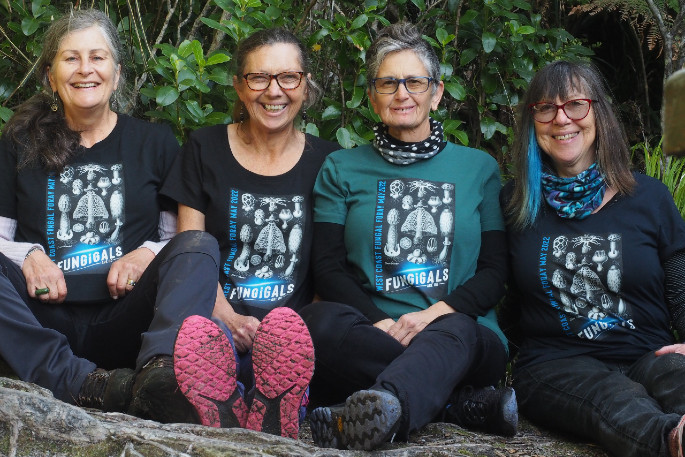As the autumn leaves fall, a spellbinding world of mushrooms awakens on the West Coast of New Zealand, beckoning fungi enthusiasts to explore its rich tapestry of species.
Over the past decade, the Fungigals – a passionate group of West Coast women comprising Annie Rogers, Kirsty Williams, Ariel Shamel, and Lesley Towart – have been exploring the region in search of its diverse mushrooms.
“We are swinging into the fungi season now and next month is when a lot of the most colourful mushrooms will be popping up,” says Kirsty.
What starts out as a walk in the bush enjoying the great outdoors can turn into an addiction once you start seeing the fungi world around you.
“To find fungi you have to really slow your pace right down and it opens up a new area and appreciation of our native forests.”
Kirsty notes that while fungi can be found throughout the country, “the rainforests on the West Coast can add an abundance of flushes of mushrooms”.
She suggests using a Shirley Kerr ‘Field Guide to New Zealand Fungi’ or the Mushrooms of New Zealand Facebook page to identify the species.
There is also a range of nature tours available for those eager to delve into the hidden wonders of West Coast fungi, offering visitors unique and educational experiences of the region’s diverse ecosystems.
Cliff Goodwin from Glacier Valley Eco Tours highlights the ideal conditions for fungi growth on the West Coast.
“Fungi require moisture to grow a fruiting-body. The West Coast is well known for its rain.
“And during the mild seasons, autumn and spring, fungi will develop fruiting-bodies above ground and produce spores for reproduction, so the West Coast has perfect conditions for fungi hunting/photography.”
Some of the most popular mushrooms found on the West Coast, according to Cliff, include the sky blue entoloma hochstetteri (werewere-kōkako), and the more elusive red/orange waxgills, cordyceps sinclairii, stinkhorn, and coral fungi.
“Others that we sometimes see are icing sugar fungus, brackets, earth tongue, bird’s nest, wine glass, bolete, ear fungus, witch’s butter, and basket fungus,” Cliff adds.
Cliff, who takes nature tours at Lake Matheson, Fox Glacier, says visitors could miss many of these without a guide as they are generally small and hidden in shady places, sometimes off the public track.
Dale Burrows, who runs Franz Josef Wilderness Tours, concurs.
“It is often the small things that are missed or overlooked that people do not notice or just walk right past but when joining a nature tour the guides are passionate about sharing every little bit of information and pointing out the small as well as the large.”
Dale has observed a surge in the mushroom population over the last two seasons, around the rainforest trail in Lake Mapourika’s kiwi sanctuary, located just north of Franz Josef. Among the thriving fungi is the striking blue e.hochstetteri, known to Māori as werewere-kōkako.
Legend says that the endangered kōkako bird acquired its distinctive blue wattle from rubbing against the blue mushroom. The werewere-kōkako also holds the distinction of being the only mushroom in the world to grace a banknote, as it is featured on New Zealand’s $50 bill, a testament to its cultural and historical importance.
Not only are mushrooms visually stunning, but they also play a vital role in the region’s ecosystem. Many of these fungi species have important symbiotic relationships with native plants, providing nutrients and support to help them grow.
“A guided nature tour into these special and unique places can really enhance a visitor’s appreciation for the West Coast’s natural beauty and biodiversity as our local guides with local knowledge can share and explain what makes these places unique and how we look after and protect the natural treasures and beauty within,” says Dion Arnold from White Heron Sanctuary Tours in Whataroa.
Dion mentioned that during a recent ‘Easter fungi hunt’ in the Waitangiroto Nature Reserve, visitors were delighted with a plethora of remarkable discoveries, including red and yellow waxgills, orange pore fungus (favolaschia calocera), and many more fascinating finds.
As the allure of the West Coast mushroom season unfolds, it presents a prime opportunity for nature lovers, fungi enthusiasts, and curious visitors alike to explore the hidden wonders of this magical world.
“The West Coast is home to some of the most exceptional and diverse natural environments, and our eco-tourism business operators are dedicated to providing world-class nature experiences, helping visitors better appreciate our untamed natural wilderness,” says Development West Coast’s nature economy project lead Zak Shaw.



